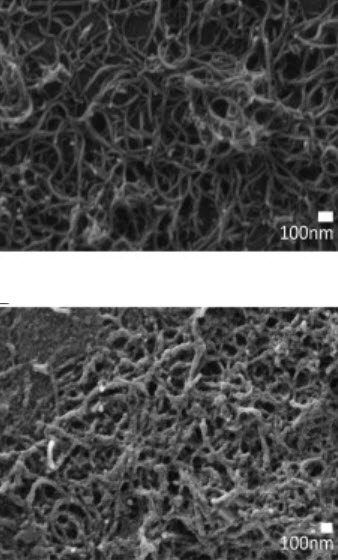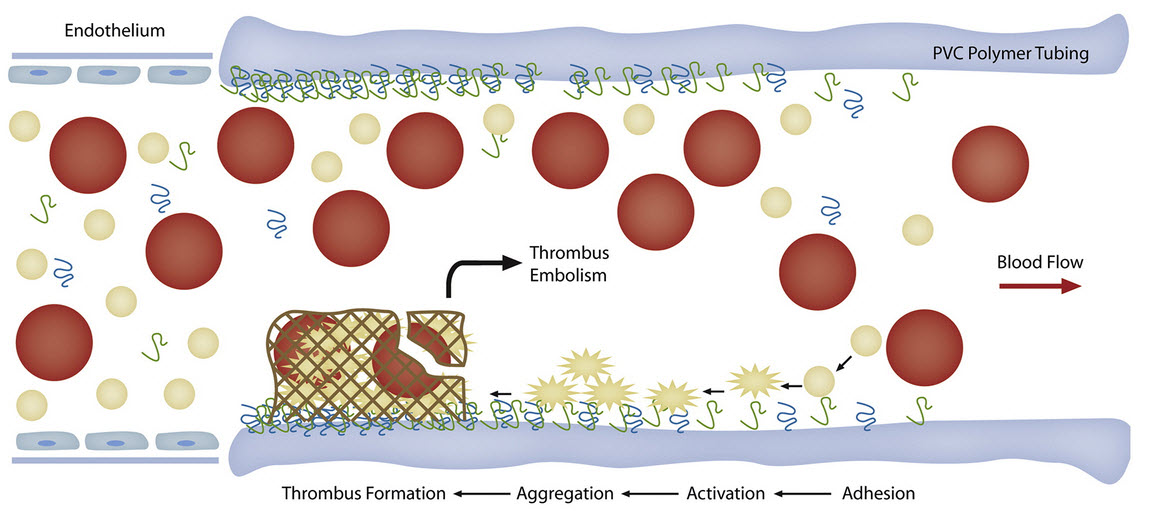Carbon nanotubes found to create blood clots in medical devices
January 26, 2015

Scanning electron micrographs of multiwall-carbon-nanotube-modified PVC prior to (top) and after (bottom) perfusion, showing platelet aggregation (credit: Alan M. Gaffney et al./Nanomedicine)
Scientists in the School of Pharmacy and Pharmaceutical Sciences in Trinity College Dublin, have discovered that using carbon nanotubes as biomaterials that come into contact with blood generates blood clots.
The reason: When blood comes into contact with foreign surfaces, the blood’s protective platelets are activated, creating blood clots.
This can be catastrophic in clinical settings where extracorporeal circulation technologies are used, such as during heart-lung bypass, in which the blood is circulated in PVC tubing outside the body.
Their findings are reported in an open-access paper published in the January issue of the journal Nanomedicine.
More than one million cardiothoracic surgeries are performed each year and while new circulation surfaces that prevent platelet activation are urgently needed, effective technologies have remained elusive.
One hope has been that carbon nanotubes, which are potentially useful biomedical materials, might provide a solution.
This led the scientists from the School of Pharmacy and Pharmaceutical Sciences in collaboration with Trinity’s School of Chemistry and with colleagues from UCD and the University of Michigan in Ann Arbor to test the blood biocompatibility of carbon nanotubes.
They found that the carbon nanotubes did actually stimulate blood platelet activation, subsequently leading to serious and devastating blood clotting.
The findings have implications for the design of medical devices which contain nanoparticles and which are used in conjunction with flowing blood.

Plasma protein deposition, platelet activation, and thrombus formation on an artificial PVC surface (credit: Alan M. Gaffney et al./Nanomedicine)
Abstract of Blood biocompatibility of surface-bound multi-walled carbon nanotubes
Blood clots when it contacts foreign surfaces following platelet activation. This can be catastrophic in clinical settings involving extracorporeal circulation such as during heart–lung bypass where blood is circulated in polyvinyl chloride tubing. Studies have shown, however, that surface-bound carbon nanotubes may prevent platelet activation, the initiator of thrombosis. We studied the blood biocompatibility of polyvinyl chloride, surface-modified with multi-walled carbon nanotubes in vitro and in vivo. Our results show that surface-bound multi-walled carbon nanotubes cause platelet activation in vitro and devastating thrombosis in an in vivo animal model of extracorporeal circulation. The mechanism of the pro-thrombotic effect likely involves direct multi-walled carbon nanotube-platelet interaction with Ca2+-dependant platelet activation. These experiments provide evidence, for the first time, that modification of surfaces with nanomaterials modulates blood biocompatibility in extracorporeal circulation.